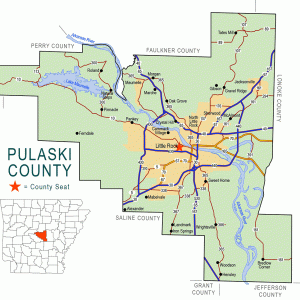calsfoundation@cals.org
Gravel Ridge (Pulaski County)
Gravel Ridge has been part of the city of Sherwood (Pulaski County) in northern Pulaski County since 2008. Before that time, Gravel Ridge was an unincorporated community surrounded by the cities of Sherwood, Jacksonville (Pulaski County), and North Little Rock (Pulaski County), as well as the unincorporated settlement of Gibson (Pulaski County) and the Little Rock Air Force Base.
As its name suggests, Gravel Ridge is a section of high ground consisting largely of loose stones. The ridge is bounded by Bayou Meto on the north and Kellogg Creek on the south. Although silver, lead, and copper deposits have been found near Kellogg Creek in Gibson, no similar minerals have been unearthed in Gravel Ridge. Moreover, once development began in the middle of the twentieth century, builders found the water level to be surprisingly low in Gravel Ridge, in spite of its proximity to two streams.
Very soon after Little Rock (Pulaski County) was established as the territorial capital of Arkansas, settlers began claiming land on the formation known as Gravel Ridge. Ezekiel Buckhannon and Jesse Owens both acquired land patents on the ridge in 1820, followed by John Loughery in 1823 and Benjamin Kellogg in 1843. Kellogg was the landowner who first found precious metals in Gibson in the 1830s and expanded his holdings in the area. Isaac O’Donnell and Moses Greenwood also purchased land on the ridge before the Civil War.
The nearest Civil War engagement, the Action at Bayou Meto (or Action at Reed’s Bridge) was several miles east of Gravel Ridge. After the war, the area remained a quiet settlement of farmers for nearly a century, until development during and after World War II brought more activity to the area. Both the work at the Arkansas Ordnance Plant in Jacksonville from 1942 through 1945 and the activation of the Little Rock Air Force Base in 1955 resulted in the building of homes and businesses in Gravel Ridge.
By 1955, the aforementioned water shortage on the ridge was noted by new homeowners, as their wells had begun running dry. Over the following years, several solutions were proposed, including establishment of a water improvement district, incorporation of Gravel Ridge as a town, and purchase of water from Jacksonville or Sherwood. Long-time residents opposed these changes, as did newer residents who had chosen to buy land on Gravel Ridge to escape the financial and legal burdens of life in an incorporated community. By 1962, Gravel Ridge had a volunteer fire department with one truck. It also had three churches, a barber shop, a television repair shop, a cabinet store, and six service stations, three of which offered small grocery stores. One also operated a body shop. The only manufacturing business in Gravel Ridge in 1962 was O. G. Kuykendall Enterprises, which made an oil additive.
As development continued in Gravel Ridge, concern grew about the lack of services in the community. In addition to concerns about water and sewer service, residents of Gravel Ridge were also dissatisfied with law enforcement from the Pulaski County Sheriff’s office. Early in the twenty-first century, both Jacksonville and Sherwood began to woo the voters of Gravel Ridge. After both cities had voted to annex Gravel Ridge, the voters of the community went to the polls on April 1, 2008. By a vote of 632 to 211, they chose to become part of Sherwood. Journalists surmised that voters preferred Sherwood over Jacksonville largely because of the lower property taxes of Sherwood.
In 2010, Gravel Ridge had about fifteen businesses, including two banks, an insurance company office, a storage facility, a barber and beauty shop, a hardware and general store, and a restaurant. In the twenty-first century, the Kuykendall firm is a cement products distributor specializing in safe rooms and storm cellars.
For additional information:
Dumas, Ernest. “Water’s the Plan, Method the Issue at Gravel Ridge.” Arkansas Gazette, January 7, 1962, p. 4A.
Hullen, Michelle. “Gravel Ridge Votes to Join Sherwood.” Arkansas Democrat-Gazette, April 2, 2008, pp. 1B, 5B.
Steven Teske
Butler Center for Arkansas Studies
 Pulaski County Map
Pulaski County Map 




Comments
No comments on this entry yet.